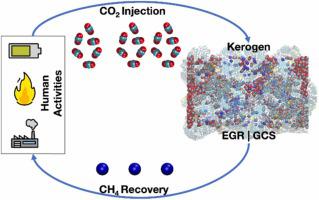Journal of CO2 Utilization ( IF 7.7 ) Pub Date : 2022-06-20 , DOI: 10.1016/j.jcou.2022.102105 Kai Bin Yu, Geoffrey M. Bowers, A. Ozgur Yazaydin

|
As the global energy demand increases, a sustainable and environmentally friendly methane (CH4) extraction technique must be developed to assist in the transition off of fossil fuels. In recent years, supercritical carbon dioxide (CO2) has been poised as a candidate for enhanced gas recovery (EGR) from CH4-rich source rocks, potentially with the reservoir serving as a carbon sink for CO2. However, the underlying molecular-scale mechanisms of CO2-EGR processes are still poorly understood. Using constant chemical potential molecular dynamics (CMD), this study investigates the CH4 recovery process via supercritical CO2 injection into immature (Type I-A) and overmature (Type II-D) kerogens in real-time and at reservoir conditions (365 K and 275 bar). A pseudo-second order (PSO) rate law was used to quantify the adsorption and desorption kinetics of CO2 and CH4. The kinetics of simultaneous adsorption/desorption are rapid in immature kerogen due to better connected pore volume facilitating fluid diffusion, whereas in overmature kerogen, the structural heterogeneity hinders fluid diffusion. Estimated second order kinetic rate coefficients reveal that CO2 adsorption and CH4 desorption in Type I-A are about two times and an order of magnitude faster, respectively, compared to those of in Type II-D. Furthermore, overmature Type II-D kerogen contains inaccessible micropores which prevent full recovery of CH4. For every CH4 molecule replaced, at least two and six CO2 molecules are adsorbed in Type-II-D and Type I-A kerogens, respectively. Overall, this study shows that CO2 injection can achieve 90 % and 65 % CH4 recovery in Type I-A and Type II-D kerogens, respectively.
中文翻译:

超临界二氧化碳增强了从干酪根微孔中采收天然气
随着全球能源需求的增加,必须开发一种可持续且环境友好的甲烷 (CH 4 ) 提取技术,以帮助摆脱化石燃料的转型。近年来,超临界二氧化碳 (CO 2 ) 已成为从富含 CH 4的烃源岩中提高采收率 (EGR) 的候选者,储层可能成为 CO 2的碳汇。然而,CO 2 -EGR 过程的潜在分子尺度机制仍然知之甚少。使用恒定化学势分子动力学(CMD),本研究通过在储层条件(365 K 和 275 bar)下将超临界 CO 2注入到未成熟(IA 型)和过成熟(II-D 型)干酪根中实时研究 CH 4采收过程。使用准二级 (PSO) 速率定律来量化 CO 2和 CH 4的吸附和解吸动力学。同时吸附/解吸的动力学在未成熟干酪根中由于更好的连通孔体积促进流体扩散而快速,而在过成熟干酪根中,结构异质性阻碍流体扩散。估计的二级动力学速率系数表明,CO 2吸附和 CH 4IA 型的解吸速度分别是 II-D 型的两倍和一个数量级。此外,过熟的 II-D 型干酪根含有难以接近的微孔,阻碍了 CH 4的完全回收。对于每个替换的 CH 4分子,至少两个和六个 CO 2分子分别被吸附在 II-D 型和 IA 型干酪根中。总的来说,这项研究表明,在 IA 型和 II-D 型干酪根中,注入 CO 2可以分别实现 90% 和 65% 的 CH 4回收率。

























 京公网安备 11010802027423号
京公网安备 11010802027423号